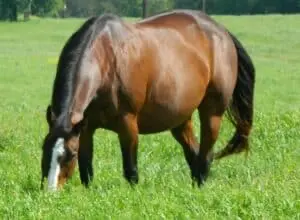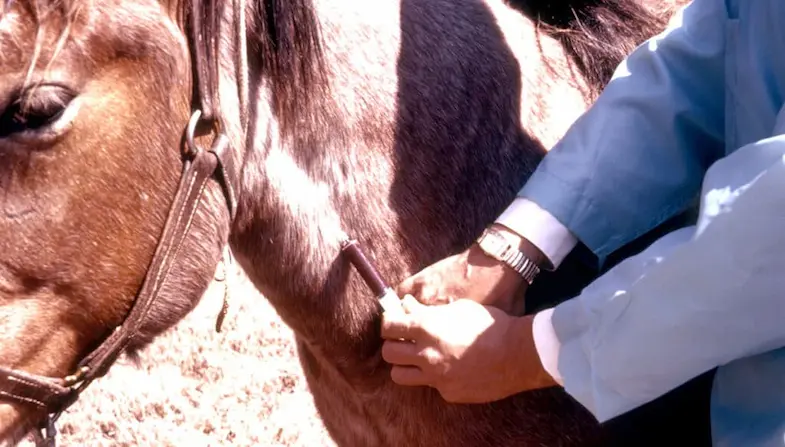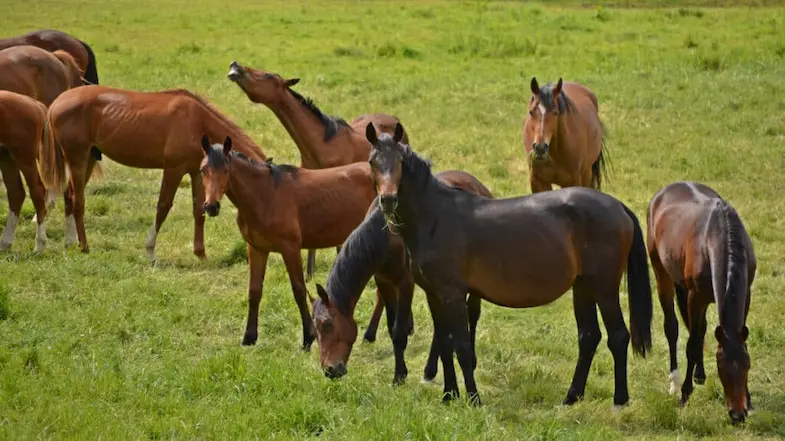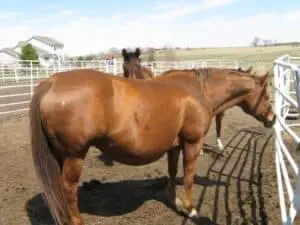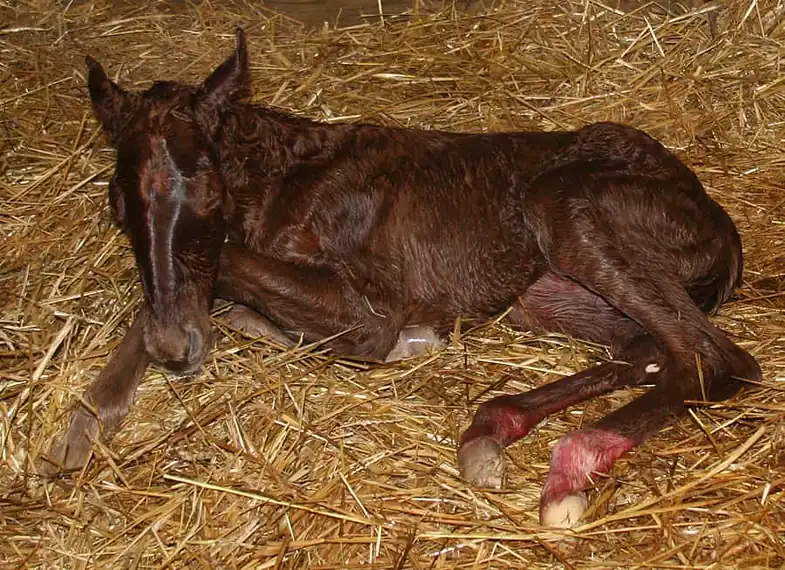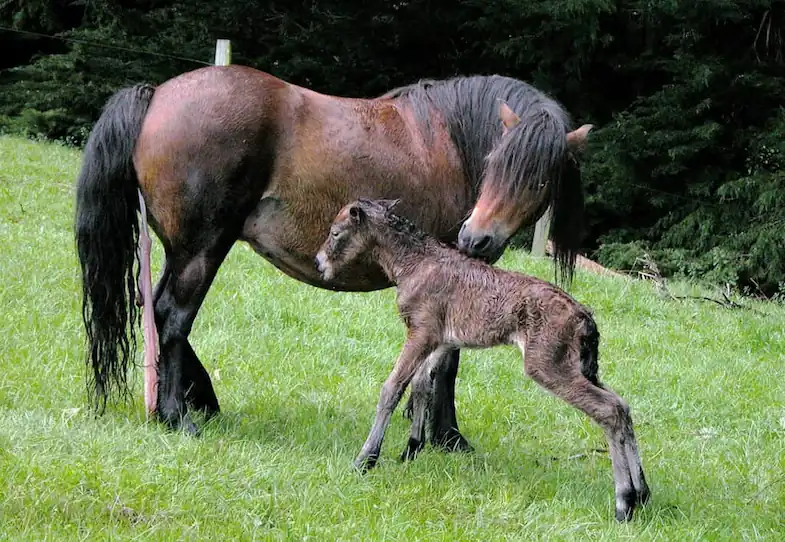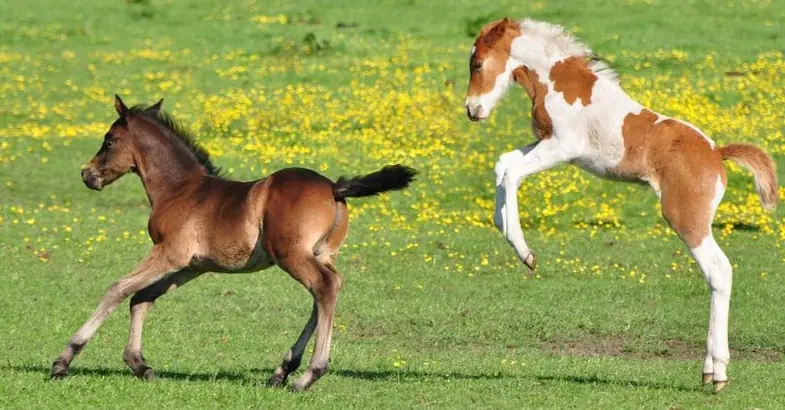Horses have been giving birth for thousands of years without our help and while in most cases they will continue to do so it’s still important to understand the different stages of pregnancy as well as how best to look after your mare. Despite having a gestation period of just under a year its during the last three months of pregnancy that the foal will do the majority of its development.
What age can a horse become pregnant?
Like many animals, horses are able to conceive at an early age but that doesn’t mean to say that they should. After all, there’s a big difference between when a horse can become pregnant and when they should. There will be some variation between horses but as a rule, most horses are able to carry a foal from around 18 months. It’s widely accepted though that it’s better to wait until a mare has reached her full size which is around the age of four. A mare can continue to produce foal well into her 20s but at this age, it does become much harder for her to conceive.
How can you tell if a horse is pregnant?
There are a number of different ways you can tell if your horse is pregnant or not depending on how long ago she was covered by the stallion. In the early days, around two weeks, she will likely change her behavior towards stallions. Instead of being receptive to them (raising her tail, opening and closing her vulva, and crouching to squirt urine or mucus) she’ll instead refuse their advances although a mare that isn’t in heat will also act the same way so this isn’t completely reliable.
You can also use a home pregnancy test kit to check if your horse is pregnant although if you do this its advisable to have the results confirmed by your veterinarian.
After 16 days a veterinarian will be able to check to see if a horse is pregnant using a variety of different methods:
- Ultrasound – This method is the most reliable which is why its also the most popular method for testing. It can take place after 16 days and involves a small probe being inserted into the horse’s rectum. This will take pictures to confirm if the horse is pregnant and, after 55 days, will also be able to sex the foal.
- Transrectal palpation – This normally takes place between 16 and 20 days after the horse has been covered and involves a veterinarian putting their hand up the mare’s rectum to check the size and shape of the uterus as well as check the ovaries for any swelling.
- Blood test – Some horses can become agitated during rectal examinations or have a small rectum which makes a blood test the best option. After the blood has been taken it’ll be tested for levels of eCG (equine chorionic gonadotrophin). In the past, eCG was known as PMSG (pregnant mare serum gonadotrophin) so you might hear your veterinarian mention this instead.
- Urine test – It normally takes around 10 minutes to get the results of a urine test and some veterinarians will do this first, then confirm the results with an ultrasound if necessary.
Can you use a human pregnancy test on horses?
There’s a lot of talk online about whether or not you can use a human pregnancy test to see if a horse (or any animal for that matter) is pregnant but the simple answer is no you can’t. The reason for this is that when a horse is pregnant it’ll produce eCG but as most human pregnancy tests measure the levels of hCG (human chorionic gonadotrophin) they won’t work on horses.
How long is the gestation period in horses?
The actual gestation is 11 months but most horses will give birth within 330 to 345 days of conceiving, that said though on average horses will give birth somewhere between 315 and 387 days. As with us, some foals are born prematurely without any complications while it’s not unheard of for a horse to give birth after 362 days, although this isn’t common.
How should you care for a pregnant horse?
While there are plenty of things that should be done before your mare is introduced to a stallion, such as making sure her vaccinations are up to date, there’s plenty that you can do for her while she’s pregnant. Where you keep her, what she eats, and how much exercise she gets will all play a role in the development of the foal.
Should you keep a pregnant mare stabled?
You might think that stabling your horse in a clean, warm and comfortable stall is the best option for her, after all, it’s secure and she will have her own space, but that’s where the problem lies. Your horse will want to be outside with the other horses, she’ll benefit much more from being out in the fresh air than she will inside.
It’s natural to want to protect your horse and her unborn foal but this is exactly what your horse wants to do too. She’ll feel more relaxed if she can graze and socialize with the other horses. Her instinct to protect her foal is so strong that, when she’s almost at the end of her pregnancy (in the last month or so), she’ll start to separate herself off from the rest of the herd. Instead of staying close to them, she’ll start to hang back from them. At this stage if you’re able to you can move her to a smaller paddock with other pregnant mares or quieter horses, this will help to keep her stress levels down and therefore keep her more relaxed.
While you don’t need to stable your horse throughout her pregnancy it’s a good idea to do so at night when she gets close to her due date. The reason for this is twofold, it will give her a safe secluded place to have the foal but if she’s giving birth during the winter will also prevent the foal from suffering from hypothermia.
What’s the best thing to feed a pregnant horse?
As with all horses its important that pregnant mares have a regular supply of freshwater, if you don’t have running water that she can drink from you should change her water a couple of times a day. This is because pregnant mares are susceptible to leptospirosis which is a bacterial disease that’s found in stagnant water and can cause the mare to abort the pregnancy.
As well as water your mare will also need to have plenty of good quality hay. One thing that is crucially important though is to make sure the hay doesn’t contain any fescue, while this is okay for other horses it contains acremonium coenophialum which can be harmful to a pregnant mare. It can lengthen the gestation period which will increase the risk of complications during foaling but can also make it very difficult, if not impossible, for the mare to produce any milk.
Throughout the pregnancy, you should make sure that your horse has food that has been specially designed for pregnant mares, its also worth keeping in mind that while she may eat a bit more during her pregnancy it’s only in the last 10 weeks when she’ll really need to increase her intake.
Should you stop deworming a pregnant horse?
You should continue to deworm your horse throughout her pregnancy but it’s important to make sure the dewormer is safe and suitable for broodmares. In fact, most veterinarians will recommend that, at least in the last month of pregnancy, the mare should be dewormed. This will reduce the number of parasites a foal is exposed to just before and after its born.
Can you ride a horse that’s pregnant?
This is a personal choice but while some people decide not to ride their horse at all while she’s pregnant most people will continue to do so. While it’s not be proven conclusively by any means there is some evidence that it can be beneficial to continue riding your horse during the first 6 to 8months of her pregnancy.
Continuing to ride after 8 months is a definite no-no though this, in part, is because as the foal starts to grow the mare’s belly will grow and adjust her center of gravity. This will make her less stable, especially at faster paces, which could be dangerous and increases her chances of falling.
What are the different stages of a horse’s pregnancy?
Just as is the case with all animals that give birth to live young, horses have three stages (or trimesters) of pregnancy.
- 0-3 months – At this stage foals will develop quickly and, by 3 months they are already starting to look like a small horse.
- 3-6 months – As the foal develops further the mare will begin to show visible signs of being pregnant, such as her belly will get bigger but her udders will also expand.
- 6+ months – As the pregnancy goes on the foal will continue to grow and the mare’s belly will expand further. Around two months before the foal is born the mare’s udders will start to secrete a sticky yellow liquid.
When a mare gets to around 315 days she’ll begin to show signs that she’s getting ready to give birth. The yellow liquid will start to turn into milk and her udders may begin to drip too, the muscles around her tail will also start to relax more. It may also appear as if her belly has dropped more as the foal turns and moves into position ready for birth. When this happens it means she’ll now ready to give birth, at this stage, it’s important to give her enough space to do so.
When do horses give birth?
Every horse is different but around 80% of them will give birth during midnight and 6am which is a through back to their wild ancestry. Horses are extremely vulnerable when giving birth (as is a newly born foal) so to reduce their chances of being attacked many horses will give birth when it’s darker and there are fewer predators around. This is why mares prefer to give birth in private without people looking on, respect this, and give your horse some space.
What happens when a horse gives birth?
For a first time breeder, it can be a worrying time when a horse gives birth but understanding the different stages can help to ease some of the worries.
Stage one (labor)
This is the longest stage for most mares and can last for anything from 30 minutes to 6 hours. It typically starts with the mare getting very restless, she may not eat or drink and will probably start to pace up and down or walk in circles, regularly looking at her flank and swishing her tail. A lot of horses will start to paw the ground while some will repeatedly lie down and get up. Some mares will also straddle and crouch to urinate a lot.
Stage two (the birth)
Stage two begins when the mare’s waters break, if she’s not already lying down she will probably do so now as the waters breaking is followed very closely by the foals front hooves and his nose. The mare may begin to sweat a lot, especially around her flanks, and will probably temporarily delay the birth if she’s disturbed at this point.
The birth itself will normally take around 15 to 20 minutes but can be a lot longer if this is the first time the mare has had a foal, although if the foal hasn’t emerged after 45 minutes it may need some help.
After the foal is born the mare will continue to lie down, this is normal so don’t worry. She’s resting and allowing blood to flow from the placental tissues to the foal. If the mare is disturbed during this time she may get up and sever the umbilical cord too early which could stress the foal heart and increase the risk of bleeding inside his brain.
Stage three (expulsion of the placenta)
Around 20 minutes after the foal is born the mare will stand up and begin to nuzzle and lick the foal. This is part of the bonding process but will also help too dry and stimulate the foal. The mare will start at the foal’s head and work her way over his body until she reaches his rear. By this time the foal is able to stand so the mare will gently nudge him from behind to encourage him to do this.
It’s also at this stage that the mare will pass the placenta (or afterbirth), this normally happens anywhere from 1 to 2 hours after the birth.
Problems during foaling
Most births go smoothly without any problems or the need for any interference at all but it’s impossible to know if this will be the case beforehand which is why many people like to have a veterinarian present (or at least within easy reach). Even if the birth went to plan it’s a good idea to have your veterinarian check the mare and foal afterward to make sure there’s nothing you’ve missed or anything to worry about.
What happens after a horse has given birth?
After the foal is born he’ll begin to stand within 30 minutes, albeit with his mother’s help, but will also be able to nibble on grass and other solid foods within a few days. That said though he’ll continue to get most of his nutrition from his mother’s milk, at least for the first few months. By 4 months though the foal will need more nutrition than his mother can provide so will start to eat more solid foods.
At three months it’s possible to wean the foal from its mother but most people choose to leave them together for longer and instead wean the foal at around 7 months.
I hope you found this article helpful. If you did I’d be grateful if you could share it please as it would really help me.
Recommended products
Over the years I have tried hundreds of different horsey products, from various blankets and halters to different treats. Some I’ve loved, others I’ve hated but I thought I’d share with you my top all-time favorite products, the ones I never leave the yard without. I’ve included links to the products (which are in no particular order) that I really think are great.
- Horse Knots by Reference Ready – If you’re like me and enjoy pocket reference guides then you’ll love this knot tying guide. These handy cards can easily fit in your pocket or attach to the saddle for quick reference. They’re waterproof, durable and are color coded to make them easy to follow.
- Mane ’n Tail Detangler – Even if you never show your horse you’ll need to detangle his tail from time to time (and possibly his mane too) which is always a challenging chore! I’ve found that if I run a little bit of detangler through my horse’s tails every few days it stops them from getting matted up and makes combing them easy, even if they’re coated in mud. I don’t know if I should admit to this or not but it also works wonders on my hair.
- TAKEKIT Pro clippers – Over the years I’ve tried a lot of different clippers and while some were obviously better than others I found these to be by far the best. They are heavier than a lot of other clippers but for me, that’s a good thing, it makes them feel more sturdy and hardwearing. On top of that they have a range of speeds so are just as good for clipping your horse’s back as they are his face. I also like the fact that they come in a handy carry case but that’s not for everybody. The company that makes them is super good and incredibly helpful too, a real bonus these days. The only thing I wasn’t keen on was the fact that it doesn’t come with any oil, but that’s not a major problem as it’s not difficult to buy lubricant.
- Shire’s ball feeder – There are so many boredom buster toys out there but I like to use these every day, regardless of whether or not my horses are bored. I find that it helps to encourage my horses to problem solve by rewarding them with treats (or pieces of fruit) but it also mimics their natural grazing behavior which helps to keep them calm and de-stressed.
- Horse safe mirror – This is a strange one that many people are surprised about but I like to put horse safe mirrors in the trailers as well as in the quarantine stalls. It helps to prevent the feeling of isolation by giving the impression of other horses being around. Being herd animals horses can get extremely stressed when they feel that they’re on their own but with these stick-on mirrors, they believe that at least one other horse is with them.
- Rectal thermometer – I know this isn’t glamourous at all but it’s vital for your horse’s well-being to be able to check their temperature and a rectal thermometer is the easiest way of doing this which is why I’ve added it to the list.
Shopping lists
I’ve also put together a few shopping lists of essential items that I’ve found helpful over the years. I’ve broken the lists down into different categories rather than put everything in one massive list 😉

